|
|
||||
|
|
by Donald Levit  Reviewers theoretically stay until the however bitter end, but though there were those who laughed on cue and applauded and one or two who said “interesting,” some did pack up and leave, while most were plain bemused or closemouthed. For my money, the whole thing had been dangerous, pure proselytizing masked as movie. This opinion may be a total misreading of motives, but in packaging, production notes and product, What the Bleep Do We Know? came across as cult or sect flypaper. “Well, at least,” commented a wag, “they didn’t ask for money.” But with its faux documentary, hail-fellow-well-met front, top-heavy with interviewee spiritualists, men of some sort of cloth, hierophants, noetic scientists, theosophists, parapsychologists, anesthesiologists, M.D.s and Ph.D.s -- the latter churned out by academia nowadays -- to holistic New Age Christopher Franke tinkle, the film offers no more than the thinnest of storylines as exemplum to validate a text hammered home in extra-dramatic lecture form. To assertions that “it’s real! about a new worldview, not science fiction” and introduces “a greatness of thought beyond those revolutions ushered in by “Copernicus, Galileo, and Bruno . . . [and] Einstein,” the work purports to flesh out the ideas of a hundred-thirty million European and American “Cultural Creatures . . . a core group who want more out of life . . . and can’t be fooled. They read a lot.” Ordinary reference works list quantum (field) theory and mechanics, but here the takeoff point is quantum physics, simplistically though still fuzzily (if earnestly) sketched as a method of changing conventional outer reality through control of individual inner processes both physical and emotional. Thus, just as one remembers the past and cannot see yet can alter the future by way of present choice, that previously set-in-stone past can now be dipped into equally as part of the continuum that includes today and tomorrow. A basketball “court of unending possibilities” demolishes the traditional, incorrect view that the reality of material things is determined and therefore beyond the observer’s influence. Credited as co-directors, Mark Vicente, Betsy Chasse and William Arntz also figure in various permutations and combinations as Director of Photography, producers and co-writers, in what seems mostly a watery Lovelier than ever as a mature woman, Marlee Matlin is courageous in unveiling herself but cannot bring much to the part of Amanda, who depends on anti-anxiety pills, is a prized still photographer with unclarified marital and sexual baggage, and confronts the world with a pained expression. Events are so tenuous that a loopy houseguest who foot-paints bedsheets (Elaine Hendrix) is dragged in solely to give a few droplets of exposition. Not because she is deaf and reads lips, but, the moral is, because she allows external and past events and things to form her, the heroine is slow to grasp the truth. Huxley’s The Doors of Perception posits hallucinogenic induction of increased awareness, but Amanda is instructed by a wise kid who invites her into his basketball world, a subway guide who pitches water’s “Chi of Love,” and a passerby musing on the power of thought. Still she is resistant, but sent unwillingly to photograph a Polish, supposedly earthy, wedding, she inexplicably shifts gears, accepts Elliot’s (John Ross Bowie) offer of a drink, than snatches several more. The following morning, hung over, released, liberated, she sits in a steaming tub and eyeliner pencils her body with bluish vine-twined hearts. The actors are burdened with computer animation, abstract in opening credits and some interviews, intriguingly childlike-explanatory about nerve impulses, cell receptors, peptides and the brain and unhappily more anthropomorphic towards the end. Lacking the scary humor of Dumbo’s drunk and the satiric wit of Heinlein’s Valentine Smith’s social-sexual church, the film’s color-coded cartoon body cells resembling shmoos or Pillsbury Dough Boys, follow the unfunny current fad of figures that play trendy music, curse, carouse, make love, are star-voiced and exaggeratedly human except for their bodies. This unusual marriage of “documentary,” story, and animation is not wedded smoothly enough to produce a coherent cinema whole. More importantly, despite declaring “the height of arrogance . . . those who create God in their own image,” What the Bleep Do We Know? would slyly do just that. The seemingly awkward title is part of that plan: we’re reg’lar folks, even cuss a tad, jus’ y’all c’mon in. You won’t leave. (Released by Samuel Goldwyn Films and Roadside Attractions; not rated by MPAA.)
|
||
|
© 2025 - ReelTalk Movie Reviews Website designed by Dot Pitch Studios, LLC |



